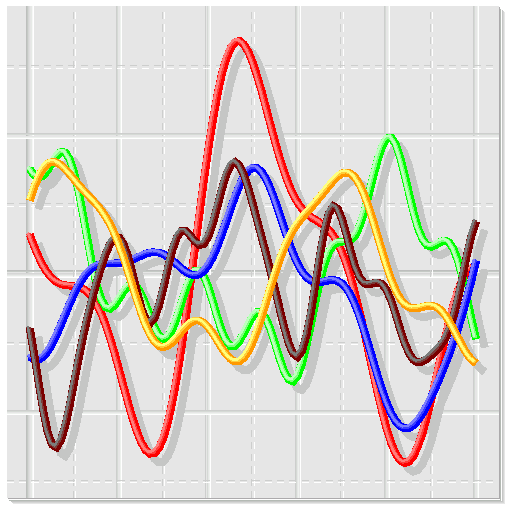xy2ps: Convert X-Y data to PostScript format plot

Requirement: Perl, gs(GNU Ghostscript: PostScript interpreter) or PostScript printer
(convert(1), cut(1), paste(1), sed(1), tac(1) etc. are suitable for working in harmony with xy2ps.)
0. How to install
$ wget http://members.jcom.home.ne.jp/maegawa/pub/xy2ps
$ chmod +x xy2ps
$ su
# cp xy2ps /usr/local/bin
1. Basic usage
When data is not given, xy2ps generates random X-Y data automatically.
$ xy2ps >temp.ps
Use gs(Ghostscript) for rendering.
$ gs temp.ps
Send PostsScript data to the printer.
$ lpr temp.ps
The two above-mentioned commands(xy2ps and gs) can be executed by one command as follows.
$ xy2ps -gs
Moreover, above is the same as the following.
$ xy2ps >~/.xy2ps/temp.ps && gs -q ~/.xy2ps/temp.ps
So you can output the previous graph to the printer as follows.
$ lpr ~/.xy2ps/temp.ps
Kicking the data to printer directly
$ xy2ps | lpr
Making image file
$ xy2ps -image | convert - portrait.jpg
$ xy2ps -image -landscape | convert - -rotate 90 landscape.jpg
2. Plot the graph of numerical data
2.1 Plot with "sample.dat"
$ cat sample.dat
Parabola data
0 0
1 1
2 4
3 9
4 16
5 25
6 36
7 49
8 64
9 81
10 100
$ xy2ps sample.dat -gs
2.2 Read data from standard input
(OK)
$ cat sample.dat | xy2ps - >temp.ps && gs -q temp.ps
(NG)
$ cat sample.dat | xy2ps - -gs
$ cat sample.dat | xy2ps - | gs -
(OK)
$ gs `locate tiger.ps`
(NG)
$ cat `locate tiger.ps` | gs -
3. Decoration
-no_pedantic
$ xy2ps -no_pedantic -gs
with various command line options to control plot(see `xy2ps -h`, `xy2ps -h2`)
$ xy2ps sample.dat -gs -xmin 0 -xmax 10 -xtick 5 -xsubt 5 -ymin 0 -ymax 100 -ytick 50 -ysubt 5 -xtitle "X axis name" -ytitle "Y axis name" -gtitle "Graph Title" -lwidth 1.2 -psym 8 -psize 7 -lcolor 1
specify line style, color, width
$ xy2ps data-file -xyxy -gs -only_axis -lwidth ".5|.5|4" -lstyle "2|1|0" -lcolor "0|2|1"
4. Multi lines
4.1 xyyy type multi column data
x y1 y2 y3...
:
:
$ ./mkxy_0 > two-lines.dat
$ xy2ps two-lines.dat -gs -no_pedantic -label "exp(-x/5)*sin(x)|exp(-x/5)" -legend_x 0.5 -legend_y 0.05
$ ./mkxy_1 > multi-lines.dat
$ xy2ps multi-lines.dat -gs -psym 1 -voffset 150
4.2 xyxy type multi column data
x1 y1 x2 y2 x3 y3...
:
:
$ ./mkxy_2 > xyxy-data
$ xy2ps xyxy-data -gs -xyxy -only_data -no_lstyle
4.3 Data point number of the each column
$ cat points.dat
1 1 1
2 4 8
3 9 27
4 16 64
5 25 125
6 36
7 49
8 64
9 81
10 100
$ xy2ps points -xlog -ylog -gs
-xyxy type ...same.
x1_1 y1_1 x2_1 y2_1 x3_1 y3_1
x1_2 y1_2 x2_2 y2_2 x3_2 y3_2
x1_3 y1_3 x2_3 y2_3
x1_4 y1_4 x2_4 y2_4
x1_5 y1_5
x1_6 y1_6
$ ./mkxy_3 100 0.25 >_1
$ ./mkxy_3 50 0.50 >_2
$ ./mkxy_3 25 1.50 >_3
$ ./mkxy_3 10 2.00 >_4
$ ./mkxy_3 5 3.00 >_5
$ paste _[1-5] > _all
$ xy2ps _all -xyxy -psym 2 -label "line-1|line-2|line-3" -no_tick -gs
Note that the column with many data point must be located in left-hand side.
4.4 Choose specified field of multi-columned data
You can select any data column by cut(1) command.
$ cut -f7,8 _all | xy2ps - >w.ps && gs -q w.ps
4.5 CSV; Comma Separated Value
The xy2ps disregards the comma(,) in data file. The CSV form data can be dealt with by using sed(1) command.
$ cat csv.dat
1,1,1
2,4,8
3,9,27
4,16,64
5,25,125
$ sed 's/,/ /g' csv.dat | xy2ps - >w.ps && gs -q w.ps
5. Command line option in data file
You can write command line option in data file.
$ xy2ps population | convert - pop.jpg
The option in data file can be disregarded by -no_file_option
$ xy2ps population -no_file_option -gs
The option in data file can be overwritten by the command line option.
$ xy2ps population -ylog -ymin 10 -ymax 10000 -legend_x 0.05 -legend_y 0.12 -npp -no_psym | convert - pop_log.jpg
Option file and Data file can be separated.
$ for i in `seq 1 5`;do xy2ps -stderr_data >/dev/null 2>_$i; done; paste _[1-$i] >data-file
$ cat option-file data-file | xy2ps - >w.ps && gs -q w.ps
This is one of the very simple execution forms. By changing 'mkgraph', any parameters are controllable.
$ ./mkgraph | xy2ps - -landscape -image | convert - -rotate 90 freevib.png
$ ./mkgraph | xy2ps - >w.ps && gs -q w.ps
6. Help
You can see usage message or more information as follows.
$ xy2ps -help
$ xy2ps -more
$ xy2ps -table
$ xy2ps -builtin
7. Why xy2ps?
Please imagine performing such work in the GUI environment.
$ ls *.dat | wc -l
100
$ for data in *.dat; do xy2ps $data | lpr; done
Probably, gnuplot will finish the same thing more efficient more beautifully and more wonderfully! However, 95% of what I want to do can be performed by 5% of gnuplot's function. It is *NOT* a bad thing, but... .
Addition
$ ./piechart test.dat | convert - pc.png
$ ./piechart -gs -doughnut -no_outline -only_ratio test2.dat
I would like to thank the autor of the Linux, Perl, gs, emacs, and many GNU tools..
-Home- -The program under construction-


